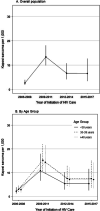Analyses of Kaposi Sarcoma trends among adults establishing initial outpatient HIV care in Nigeria: 2006-2017
- PMID: 35313941
- PMCID: PMC8935748
- DOI: 10.1186/s13027-022-00424-4
Analyses of Kaposi Sarcoma trends among adults establishing initial outpatient HIV care in Nigeria: 2006-2017
Abstract
Background: The incidence of Human Immunodeficiency Virus (HIV)-associated Kaposi Sarcoma (KS) in the pre-antiretroviral therapy (ART) population remains high in several countries in sub-Saharan Africa. We examined trends of KS prevalence in adults, establishing initial outpatient HIV care from 2006 to 2017 in Nigeria.
Methods: We analyzed data of 16,431 adults (age ≥ 18 years) enrolled for HIV care from January 1, 2006, to December 31, 2017, in a large clinic in Jos, Nigeria. KS at enrollment was defined as KS recorded in the electronic health record within 30 days of clinic enrollment. Time trends were compared among four periods: 2006-2008, 2009-2011, 2012-2014, and 2015-2017 using logistic regression models. Annual trends were analyzed using join point regression and restricted splines.
Results: The study population had a mean age 35.1 (standard deviation, SD 9.5) years, and were 65.7% female (n = 10,788). The mean CD4 cell count was 220 (95% CI 117-223). The overall KS prevalence at entry was 0.59% (95% CI 0.48-0.72). Compared to 2006-2008, KS prevalence was significantly higher in 2009-2011 (adjusted odds ratio 5.07 (95% CI 3.12-8.24), p < 0.001), but remained unchanged in subsequent periods. Male sex and low CD4 T-cell count independently increased odds for KS.
Conclusions: Despite ART expansion, KS at enrollment showed no significant decline. The low CD4 cell count, across all periods, indicates delay in enrollment for HIV care, which increases KS risk. Interventions aimed at early HIV diagnosis and linkage to ART is critical to KS risk reduction in this population.
Keywords: Africa; Antiretroviral therapy; Epidemiology; Human Immunodeficiency Virus; Kaposi Sarcoma.
© 2022. The Author(s).
Conflict of interest statement
All authors declare no competing interest.
Figures




Similar articles
-
Incident Kaposi sarcoma during the expansion of antiretroviral therapy eligibility in Nigeria: a retrospective cohort study.BMC Cancer. 2023 Sep 21;23(1):890. doi: 10.1186/s12885-023-11402-3. BMC Cancer. 2023. PMID: 37735371 Free PMC article.
-
Incidence rate of Kaposi sarcoma in HIV-infected patients on antiretroviral therapy in Southern Africa: a prospective multicohort study.J Acquir Immune Defic Syndr. 2014 Dec 15;67(5):547-54. doi: 10.1097/QAI.0000000000000360. J Acquir Immune Defic Syndr. 2014. PMID: 25393941 Free PMC article.
-
A prospective ascertainment of cancer incidence in sub-Saharan Africa: The case of Kaposi sarcoma.Cancer Med. 2016 May;5(5):914-28. doi: 10.1002/cam4.618. Epub 2016 Jan 28. Cancer Med. 2016. PMID: 26823008 Free PMC article.
-
Pediatric Kaposi sarcoma in context of the HIV epidemic in sub-Saharan Africa: current perspectives.Pediatric Health Med Ther. 2018 Apr 19;9:35-46. doi: 10.2147/PHMT.S142816. eCollection 2018. Pediatric Health Med Ther. 2018. PMID: 29722363 Free PMC article. Review.
-
Human immunodeficiency virus-associated Kaposi sarcoma as an immune reconstitution inflammatory syndrome: a literature review and case report.J Periodontol. 2008 Feb;79(2):362-8. doi: 10.1902/jop.2008.070225. J Periodontol. 2008. PMID: 18251652 Review.
Cited by
-
Incident Kaposi sarcoma during the expansion of antiretroviral therapy eligibility in Nigeria: a retrospective cohort study.BMC Cancer. 2023 Sep 21;23(1):890. doi: 10.1186/s12885-023-11402-3. BMC Cancer. 2023. PMID: 37735371 Free PMC article.
References
-
- Centers for Disease C Kaposi's sarcoma and Pneumocystis pneumonia among homosexual men–New York City and California. MMWR Morb Mortal Wkly Rep. 1981;30(25):305–308. - PubMed
-
- Rohner E, Valeri F, Maskew M, Prozesky H, Rabie H, Garone D, Dickinson D, Chimbetete C, Lumano-Mulenga P, Sikazwe I, et al. Incidence rate of Kaposi sarcoma in HIV-infected patients on antiretroviral therapy in Southern Africa: a prospective multicohort study. J Acquir Immune Defic Syndr. 2014;67(5):547–554. - PMC - PubMed
-
- Bray F, Ferlay J, Soerjomataram I, Siegel RL, Torre LA, Jemal A. Global cancer statistics 2018: GLOBOCAN estimates of incidence and mortality worldwide for 36 cancers in 185 countries. CA A Cancer J Clin. 2018;68(6):394–424. - PubMed
Grants and funding
LinkOut - more resources
Full Text Sources
Research Materials

